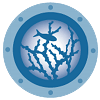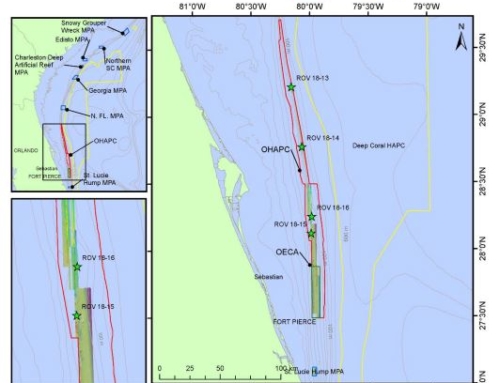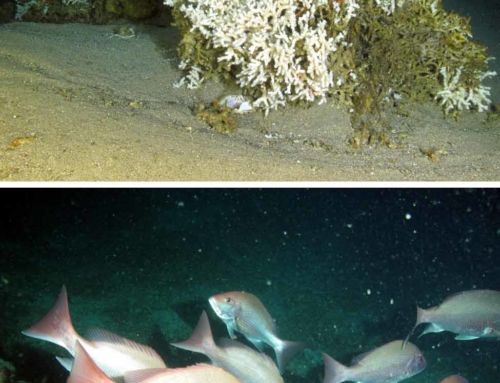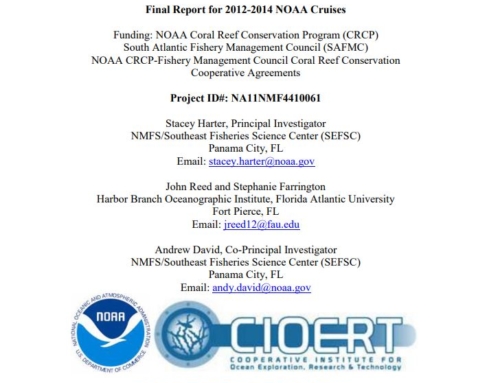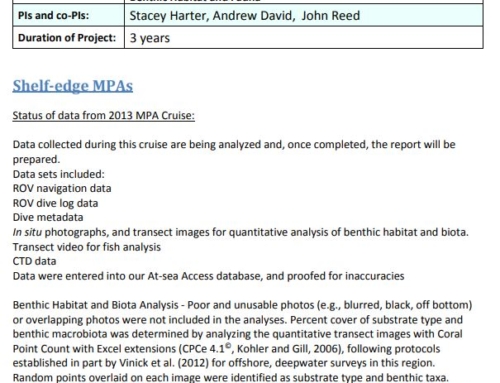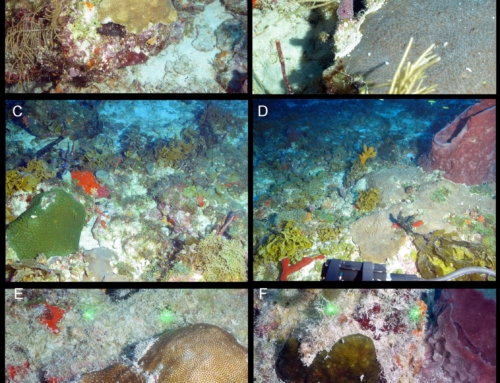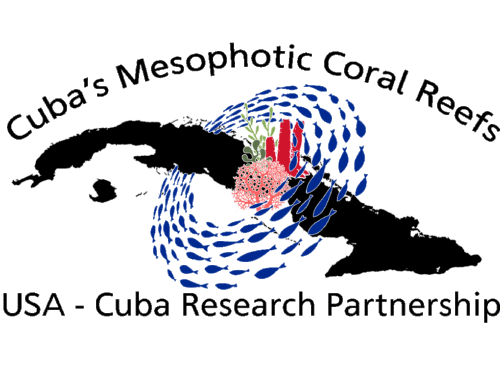Project Description
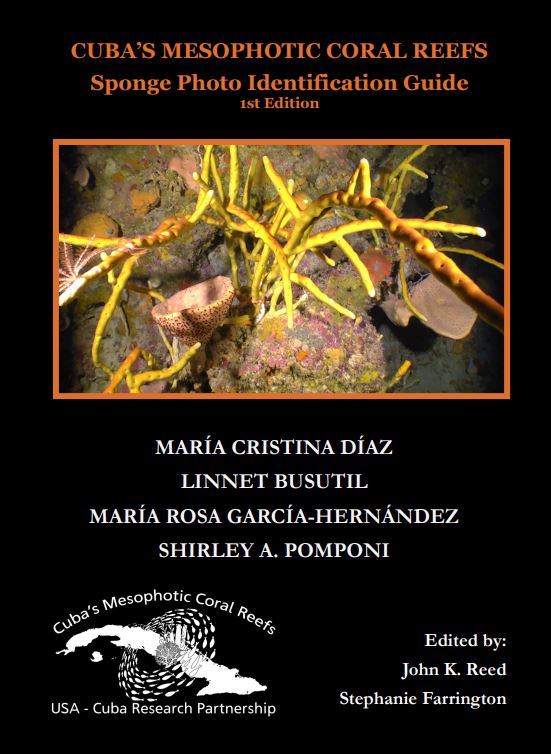
Cuba’s Mesophotic Coral Reefs- Sponge Photo Identification Guide, Edition 1
María Cristina Díaz, Linnet Busutil, María Rosa García-Hernández, Shirley A. Pomponi
Introduction
Mesophotic coral reef ecosystems (MCEs) are light-dependent benthic communities that occur deeper than shallow reefs and typically range from depths of 30 m to the bottom of the photic zone, which may extend to >150 m in some regions. MCEs represent in part an extension of shallow-water coral reef ecosystems and support a diverse assemblages of habitat[1]building taxa, including corals, sponges and algae, and associated fish (Reed et al., 2018).
Many MCEs worldwide appear to be thriving compared to shallow reefs. The deep reef refugia hypothesis suggests that MCEs may be less impacted from natural and anthropogenic impacts than shallow coral reefs, and may be more stable and resilient than shallow reefs. MCEs may also act as refugia for shallow reef species through the export of fish and coral larvae. However, it is now apparent that MCEs are also vulnerable to disturbances from all facets of perturbations including climate change, bottom trawling, invasive species, and pollution.
Whereas considerable data have been reported regarding the distribution, ecology, and health of Cuba’s shallow reefs, relatively little is known about the distribution, community structure and health of Cuba’s deep mesophotic reefs. Cuba’s strong marine policies and legislation has already resulted in 105 MPAs, covering nearly 25% of its insular shelf, yet overfishing, poaching, pollution and global warming are threats to these vulnerable ecosystems, as reefs worldwide are threatened.
This photo album of selected sponges associated with Cuba’s mesophotic reefs resulted from a recent joint Cuba-U.S. expedition that was conducted from May 14 to June 13, 2017 to map and document the extent and health of MCEs along the entire coastline of Cuba. Total ship transit around the island covered ~2,778 km (~1,500 nmi). Forty-three Remotely Operated Vehicle (ROV) dives at 36 stations confirmed the presence of MCEs habitat on all coasts of Cuba (Reed et al. 2018; Figure 1, Table 1).
ROV dives surveyed reefs from depths of 188 m to 18 m, covered 27 km, totaled 99 hours of bottom time, and resulted in 110 hours of high-definition video. A total of 21,146 digital still images documented habitat and species. The primary geomorphological features were the Deep Island Slope (125- >150 m), Deep Fore[1]Reef Escarpment (the ‘Wall’, 50-125 m), and Deep Fore-Reef Slope (30-50 m). Most vertical surfaces of the Wall were covered with dense sponges, algae, octocorals, and black corals. Agaricia was the most abundant scleractinian genus on the Wall at depths of 50-75 m, and was observed to 122 m.
Cuban MCEs have proved to be a very favorable habitat for marine sponges in both species richness and abundance. Our initial estimate of 296 morphospecies from our first video and photographic analysis during the 2017 cruise (Reed et al., 2018) was indicative of the potential high sponge diversity we were finding in Cuban mesophotic reefs. Particularly considering the fact that, the total sponge diversity currently reported from the Tropical Western Atlantic mesophotic reefs is of 241 species (Pomponi et al., 2019). As we have started curating the visual material and comparing to the present literature we have reinterpreted some morphospecies, and determine that some morphotypes are variants of one species. This sponge book represents a total of 230 species of Porifera that are distinguished by their external appearance (morphospecies), and characterized with respect to their shape, surface, and oscule attributes (excurrent apertures). An identification page was created for each morphospecies, which includes a synoptic description, a photograph, its taxonomic classification, data of its depth, and locality. Some features for each morphospecies was measured to facilitate the identification process. Some photographs show two laser dots that are 10 cm apart; however, in some cases the image has been cropped to show the species with more clarity. The species are organized taxonomically, and their classification is listed with each photograph. Six species belong to the class Calcarea, eight to the class Homoscleromorpha, and the rest belong to the class Demospongiae. Sixteen morphospecies could only be recognized to the class level of Demospongiae. The most diversified genera were: Agelas (Order Agelasida), Aplysina (Order Verongiida); Callyspongia, Xestospongia and Niphates (Order Haplosclerida. Of the total 230 morphospecies, 117 were identified to species level, the rest were tentatively assigned to genera, families, orders, or classes, and are the subject of ongoing taxonomic research.
Sponges colonized all depths and substrates surveyed. The deepest records were a bright yellow Verongiida sp. Cu-01 encrusting on rock (183 m deep), Xestospongia sp. Cu-01 (168 m), Ceratoporella nicholsoni (159 m), X. muta (134 m), and Leucetta sp. (124 m). Peak diversity started at depths of 100-125 m in which sponge morphologies (crusts, plates, tubes, spherical, vases, and branches) and multicolor patterns abounded. From the collections, there are at least 10 sponge species that are new to science within the genera of Aplysina and Verongula (Verongiida); Amphimedon, Callyspongia, and Xestospongia (Haplosclerida); Clathria (Poecilosclerida); Cinachyrella (Tetractinellida); Aaptos (Suberitida); Erylus (Tetractinellida) and Plakortis (Homosclerophorida). Two new species of Callyspongia, C. pedroi and C. alcoladoi were recently described, and a key to distinguish the eight ramose thin branching Callyspongia species from the Caribbean was created (Busutil at al., 2018).
Only two sponge species were present at all sites (Reed et al., 2018). The first, Xestospongia sp. Cu-01, may be a new species and resembles X. muta, but with thicker walls and is relatively shorter and chubby in appearance. The second, as yet unknown, is a thick bright yellow verongiid crust (Verongiida sp. Cu-01) that lacks any fiber skeleton. Three species were found at 33 sites (Agelas sceptrum, Aiolochroia crassa, and X. muta). The most species-rich sites for sponges were found at Site C-07 (Archipelago Colorados) on the northwest coast with 72 taxa and, on the south coast, C-28 (Archipiélago Los Canarreos) with 68 taxa and C-50 (Chivirico) with 66 taxa. However, overall the most species-rich region for sponges was the northeastern region (153 taxa), followed by the southeastern region (148 taxa) and western region (142 taxa). The fewest taxa were found in the northwest region (113 taxa) and southwest (131 taxa). By station, the fewest sponges were found at Site C-52 (33 taxa) and C-52A (37 taxa) at Punta Imías on the southeast coast, and C-58A (36 taxa) at Archipiélago Sabana-Camagüey on the northeast coast.
It is important to note that the sponge species included in this guide represent our first attempt to characterize the diversity for this conspicuous component of the mesophotic coral reef benthos from image data (videos and photographs) during the expedition in 2017. Some taxa originally identified as distinct morphospecies have been recognized as variants of the same species, once they were carefully studied and compared to published descriptions of those species (e.g., three different morphologies of Agelas sceptrum). However, as photographic material is curated to extract ecological data, we are finding more morphospecies that we have not characterized, therefore we do not consider that this first attempt represents the total Porifera diversity from Cuban mesophotic reefs.
Currently, one hundred of the morphospecies in this sponge book are represented from our 2017 ROV collections (115 samples collected), leaving an important portion of the morphospecies, shown here, to be collected, curated and taxonomically determined. We will approach the integrative study (morphology and genetics) of the unknown species in our collection, and we are developing collaborative projects to study some of the rarest species of this fauna. Sponge taxa were identified using the World Porifera database (Van Soest et al., 2019), a various sources of Caribbean literature, and “The Sponge Guide” (Zea et al., 2014). The present guide constitutes the most extensive representation of mesophotic Caribbean sponge fauna and will facilitate the interpretation of the regional and local patterns of mesophotic reef sponge diversity in Cuba and elsewhere on the Greater Caribbean. The study of the Porifera in Cuba owes its important advance to the work done by Dr. Pedro M. Alcolado (1948-2017), a researcher who devoted his 46 years of scientific life to 7 oceanological research and was one of the first Cuban marine ecologists. A significant part of his extensive work was dedicated to the ecology and taxonomy of the sponges, reporting around 280 species for Cuba, including 19 new species for science (Alcolado, 2002, 2007), as well as a number of contributions related to the ecology of this group. Dr. Alcolado was also mentor and master tutor of the coauthor, who describes in 2018 the first two new recognized species for the Cuban mesophotic reef (Busutil et al., 2018).
In this book, each species is presented with the following data: an in situ image, the lowest available scientific name, species author/date, higher taxonomy, depth and location of the specimen, description of the specimen, and the image name. In some cases if the specimen was collected, there are lab images and some microscopic images of the fibers. A brief synoptic description of diagnostic features such as shape, color, surface, and oscule morphology is given. Most descriptions include the measurement of the oscules, or of a surface feature such as conules, fistules, and/or body size. Also there is an Identifier field and an Identification Qualifier field. All identifications were made by M.C. Diaz and L. Busutil unless otherwise noted. *= ID from image only; **= ID from image and specimen collected in the region, and ***= ID specifically from the specimen in the image.
Díaz, María Cristina, Linnet Busutil, María Rosa García-Hernández, and Shirley A. Pomponi. 2019. Cuba’s Mesophotic Coral Reefs- Sponge Photo Identification Guide, Edition 1; Editors- John K. Reed, Stephanie Farrington. Cooperative Institute for Ocean Exploration, Research, and Technology (CIOERT) at Harbor Branch Oceanographic Institute, Florida Atlantic University (HBOI-FAU). First Edition: June 2019. Harbor Branch Oceanographic Institute Contribution Number 2256.

